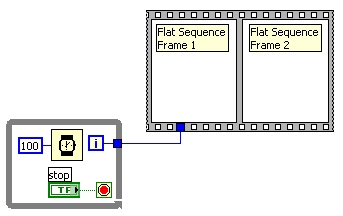- Subscribe to RSS Feed
- Mark Topic as New
- Mark Topic as Read
- Float this Topic for Current User
- Bookmark
- Subscribe
- Mute
- Printer Friendly Page
Darren's Weekly Nugget 06/12/2006
06-12-2006 11:40 AM - edited 06-12-2006 11:40 AM
- Mark as New
- Bookmark
- Subscribe
- Mute
- Subscribe to RSS Feed
- Permalink
- Report to a Moderator



Message Edited by Darren on 06-12-2006 11:42 AM
06-12-2006 12:10 PM
- Mark as New
- Bookmark
- Subscribe
- Mute
- Subscribe to RSS Feed
- Permalink
- Report to a Moderator
That's nice to know. Is it mentioned in the help for the sequence structure? (Not that I'd expect anyone to go read the help for the sequence structure if the code wasn't working... ![]()
___________________
Try to take over the world!
06-12-2006 12:23 PM
- Mark as New
- Bookmark
- Subscribe
- Mute
- Subscribe to RSS Feed
- Permalink
- Report to a Moderator
Yes, the help does mention this fact. Here's an excerpt from the on-line help for the Flat Sequence Structure:
"Data flow for the Flat Sequence structure differs from data flow for other structures. Frames in a Flat Sequence structure execute from left to right and when all data values wired to a frame are available. The data leave each frame as the frame finishes executing."
But in my defense, when I encountered this behavior, I was using a very early pre-release version of LabVIEW 7.0...I'm guessing the help hadn't been written yet. 😉
-D
06-12-2006 12:33 PM
- Mark as New
- Bookmark
- Subscribe
- Mute
- Subscribe to RSS Feed
- Permalink
- Report to a Moderator
I didn't know about this "feature", and I'm not sure what to think of it. It would seem to me to be a potential source of more errors, as your experience indicated. I guess, though, it doesn't really matter whether you like it or not. If you don't like it, don't use it. You just need to be aware of it.
06-12-2006 12:58 PM
- Mark as New
- Bookmark
- Subscribe
- Mute
- Subscribe to RSS Feed
- Permalink
- Report to a Moderator
I wasn't part of the original decision making process on the Flat Sequence Structure, but I can see how it would be rather restrictive if only certain wires could enter non-initial frames of a Flat Sequence structure. I haven't ever run into a case where I would need the behavior illustrated in my third screenshot above, but there is the possibility that I will need it someday in the future, and I'm glad it's there just in case.
-D
06-12-2006 01:05 PM
- Mark as New
- Bookmark
- Subscribe
- Mute
- Subscribe to RSS Feed
- Permalink
- Report to a Moderator
At first thought, this sounds like a "poor man's" rendevou
Ben
06-14-2006 01:34 PM
- Mark as New
- Bookmark
- Subscribe
- Mute
- Subscribe to RSS Feed
- Permalink
- Report to a Moderator
I've used this to ensure that all of my state machine states are cleaned up before the queue is destroyed (see attached image).
Was the flat sequence really necessary? Well, no, but it's pretty clean looking.
Joe Z.
06-14-2006 02:25 PM - edited 06-14-2006 02:25 PM
- Mark as New
- Bookmark
- Subscribe
- Mute
- Subscribe to RSS Feed
- Permalink
- Report to a Moderator
Ton (or did i not understand what Warren said)
Message Edited by TonP on 06-14-2006 09:30 PM
Message Edited by TonP on 06-14-2006 09:35 PM
Nederlandse
My LabVIEW Ideas
LabVIEW, programming like it should be!
06-14-2006 02:35 PM
- Mark as New
- Bookmark
- Subscribe
- Mute
- Subscribe to RSS Feed
- Permalink
- Report to a Moderator
06-14-2006 05:07 PM
- Mark as New
- Bookmark
- Subscribe
- Mute
- Subscribe to RSS Feed
- Permalink
- Report to a Moderator
@TonP wrote:
What am i missing (see attachment) where the second frame waits for the first. is this only applicable for non UI-vis?
Ton (or did i not understand what Warren said)
In your example, the frames execute sequentially of course. Darrens nugget discusses how individual sequence frames execute in relation to other parts of the code. In the example:

Frame 1 and the while loop can execute simultaneously because there is no data dependency. Frame 2 must wait until both frame 1 AND the while loop have completed.
